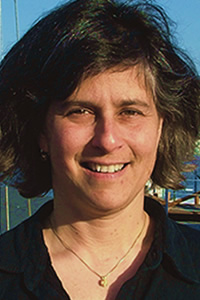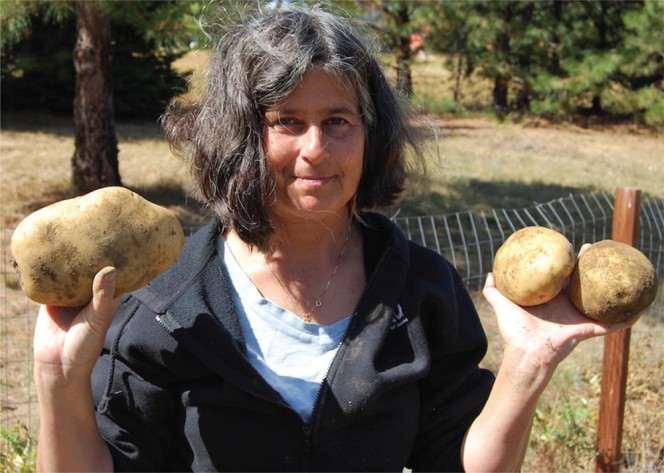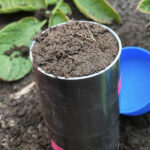
Sally Brown
BioCycle November 2015
As I write this, the number one film at the box office not only tells a cool story, has a great star, and got excellent reviews, it has the potential to bring an awareness of the benefits of biosolids to the movie going public. Spoiler alert here — The Martian starring Matt Damon tells the story of how he survives for four years on Mars after being accidentally left behind by his crew. And a key to his survival is pee and poop, aka the building blocks of biosolids. Matt plants potatoes in the Martian soil and helps them grow by adding his own urine and feces to the soil as a source of nutrients. This is a fun little addition to the plot for those of us familiar with wastewater treatment.
However, for the vast majority of moviegoers, the concept of recycling human waste is a revolutionary idea. As an example, I recently gave a talk about my research to a group of executives from Amazon. One woman got so excited because what I was talking about was just like she had read in The Martian (talk was before the movie came out). The same woman lives in an area where all of her urine and feces are treated to remove pathogens and then used to fertilize trees and wheat grown in the state. A portion of her by-products are even used to make compost, which she could use to grow her own potatoes.
In fact — take this Matt Damon — I do use a biosolids based product to grow potatoes. And I would wager some serious money that my potatoes are bigger and better than any potatoes Matt could grow on Mars or Earth. So this movie gives us two things. It introduces the whole notion of urine and feces as having value to a very broad audience. It also gives us a basis of comparison that we can use to show what centralized wastewater treatment adds to that pee and poop. Despite critics to the contrary, the answer here is not metals or pharmaceuticals. Rather the answer is protection of public health.
Contrast And Compare: Humanure V. Biosolids
People often don’t get that wastewater treatment produces a more valuable product than straight human waste or humanure. In fact, there are those that argue that humanure or direct use of human waste is a great thing but that biosolids are a whole different ballgame, chock full of metals, pharmaceuticals and other contaminants. So let’s examine human waste and biosolids to see what is the same and what is different. Here, we’ll go to the peer review literature instead of the movie set. However tempting it would be to do a direct comparison, I think this approach has more scientific merit.
Basic N-P-K Value
We can start with the basic value of the material. What Matt used directly and what I use postprocessing have high concentrations of nitrogen and phosphorus, both critical plant nutrients. While quantities will vary based on how much you eat and how your waste gets treated, it seems that Matt has an edge on me in this category. Approximate annual per capita production of nitrogen (N), phosphorus (P) and potassium (K) in human waste and biosolids are shown.
So both products are good, but Matt has an edge on me here. Centralized wastewater treatment uses water to carry wastes to be treated and one of the primary missions of that treatment is to make that transport water as clean as possible before it is released or reused. As a result, much of the N and almost all of the K I send down the pipe gets put back into the atmosphere or the receiving waters. We also both add organic matter or carbon (C) to the soils in the process. On this we are just about even. Matt adds somewhere between 6.6 to 14 kg/year of carbon while my biosolids add 5 to 16 kg C each year.
Metals
Now lets move on to the metals. Way back when Matt was in middle school (Wikipedia says he is 45 years old), metals in biosolids were a major concern. There was a lot more industry in the U.S. and that was before the industrial pretreatment regulations had been promulgated. Those regulations limit the quantity of specific metals and other compounds each commercial operation can discharge into the municipal wastewater system. Now a significant portion of the metals in biosolids comes from — you guessed it — pee and poop.
There are relatively few studies in the literature that talk about the human waste concentrations of each of the regulated metals in biosolids. You will find a disproportionately larger number of studies about behavior and concentrations of metals in biosolids and biosolids-based products. Cadmium (Cd) is a focus of many of these papers. It is a concern because plants grown in Cd-contaminated soils can take up significant amounts of Cd. When people with poor diets that are lacking in essential metals eat these crops, they can get very sick. The most famous example of this is Japanese subsistence rice farmers in the decades after World War II. It is also recognized that smoking is a major source of Cd because tobacco takes up Cd from soils and it is released into your lungs when you smoke. While a portion of the Cd that people are exposed to will stay in their kidneys and liver, a significant portion comes out in their urine.
So how does cadmium in pee compare to Cd in biosolids? Here I am going to use the Tacoma (WA) TAGRO potting soil as my example of biosolids. It is made with their Class A biosolids and aged wood. That is what I used to grow my potatoes and so that comparison seems fitting.
It turns out that smoking isn’t the only thing that increases your daily Cd intake. Oysters are also high in the metal. Matt, being a movie star, likely indulges in oysters and champagne. He is also from the Boston area, so there is the off chance that he likes fried clams even better than oysters. Even if he doesn’t though (and likely oysters were not on the menu in Mars), the Cd in his urine is higher than the Cd in my TAGRO potting soil.
Another metal that people are worried about is arsenic (As). Plants don’t take up As so the exposure pathways of concern are inhalation, eating soil or drinking As-contaminated water. It turns out that oysters and other fish and shellfish can also be enriched in As. If you don’t eat fish and you limit your occupations, the total As in your pee is typically about 0.01 ppm. If Matt had pursued an alternative career instead of acting — say semiconductor or glass manufacturing or electronics research — his As exposure would have skyrocketed, even worse than it would have from eating the occasional oyster.
A study published in 1990 found that electronics researchers, a respectable profession, had As concentrations in their pee ranging from 4.6 to 18.6 ppm. Now how about my TAGRO? The plain biosolids in Tacoma has total As concentrations of 6.9 ppm, about the same as the mean biosolids concentrations in the U.S., according to the last EPA survey (link in online version of article). The potting soil however, has total As of 3.4 ppm. So my TAGRO has more arsenic than Matt’s pee but less than somebody who works in electronics.
Newer Compounds
Lately it seems that people really mistrust municipal biosolids because of the potential presence of newer compounds including pharmaceuticals, endocrine disruptors and antimicrobials. People get really nervous about those. So nervous they likely take more pharmaceuticals to calm down. These compounds are not regulated or regularly measured in biosolids. What is easy to forget in all the worrying is that the primary source of these compounds is not some factory, but rather all of the people that contribute to the wastewater system.
Let’s start here with the antimicrobial compound triclosan. This is one of two antimicrobials that are ubiquitous in household products including toothpaste, cosmetics, and soaps. A study by the Centers for Disease Control tested over 2,500 urine samples and found triclosan in 75 percent of them. The mean concentration of triclosan, normalized for creatinine, was 12.7 ppm with a 95th percentile concentration of 364 ppm. Creatinine is a breakdown product of creatine that is found in all muscle tissue and is released through the kidneys. It is used to give a common unit for urine concentrations that is relatively constant no matter how much coffee or water you drink.
If Matt was washing his hands on Mars, there is an excellent chance that he fell into that 75 percent. That means his potatoes were getting a little dose of triclosan with every “watering.” My potatoes also got a little triclosan — a very little bit. Researchers from Purdue University led by Michael Mashtare measured the concentrations of a range of these emerging contaminants in biosolids-based fertilizers including both the biosolids cake from Tacoma and the TAGRO potting soil I used for my potatoes. Triclosan was in the cake at concentrations of about 20 ppm, above the mean in urine but not by much. In the potting soil, likely as a result of decomposition and some dilution, that concentration was a lot lower — under 2 ppm. In fact all of the products that they tested had concentrations similar to or lower than the Tacoma cake.
Bisphenol A (BPA) is another of the compounds people worry about. It is a plasticizer and found in many places you find plastic, e.g., water bottles, CDs, DVDs, linings in food and beverage cans and sporting goods. Likely Matt had some type of BPA, even on Mars. Also likely that it showed up in his pee. A study of kids in China found traces of this compound in all of the children’s urine sampled. Of the 287 samples collected from kids ranging in age from 3 to 24, 100 percent had BPA in their pee. The mean concentration (adjusted for creatinine) was 2.75 ppm. That happens to be just a smidge higher than the scientists from Purdue found in the TAGRO biosolids (2.5 ppm). In the potting soil, that concentration was effectively zero, just at or below detection limits.
This article giving you a headache? You can bet that Matt had a number of headaches, stranded all alone there on Mars. Turns out that within two hours after taking 200 mg of ibuprofen, it starts showing up in your pee. Peak concentrations of about 24 ppm occur two to six hours after, and gradually decrease unless you take another pill. The scientists at Purdue found traces of ibuprofen in the biosolids cake from Tacoma and a few of the other biosolids-based materials at concentrations ranging from 0.2 to 0.45 ppm, There was none to be found in the TAGRO potting soil.

BioCycle columnist Sally Brown displaying potatoes grown in soil amended with the City of Tacoma (WA) biosolids product, TAGRO.
The Better Potato?
So what grows a better potato, Matt’s pee and poop or my TAGRO? Truth be told, both can likely grow a very nice potato. Sweating the details, you can see that in terms of nutrients, Matt has an advantage. Metals, his is likely a touch higher in Cd, me a touch higher in As, so I’ll call that a draw. For these new compounds that people are so nervous about, Matt’s potatoes are getting a higher dose pretty much all around. Human urine appears to have higher concentrations than biosolids for the compounds that we looked at. So one could argue that this recent public concern and mistrust of biosolids, but comfort with “humanure,” is really much ado about nothing. That also suggests that human exposure to these compounds is even higher still — and biosolids have nothing to do with this.
The critical thing that my TAGRO has over Matt’s “material” is that mine is treated and tested to be pathogen free. They likely didn’t make a big deal about this in the movie. Who wants to see Matt Damon battling cholera, giardia or any other intestinal disease on the big screen? The biggest public health accomplishment of the 20th century in the developed world was taking pathogens out of our drinking water and our wastes through water and wastewater treatment. That means that I can eat my potatoes and not worry that they’ll make me sick. Matt can’t say that. And for that reason my potatoes trump Matt’s — hands down.
Sally Brown is a Research Associate Professor at the University of Washington in Seattle and a member of BioCycle’s Editorial Board.









